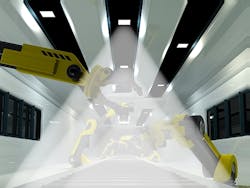At next week’s Hannover Fair, Germany’s Fraunhofer will demonstrate a factory floor robot sending information via lightwaves in a Li-Fi system.
With more and more vendors starting to push LED lighting “beyond illumination,” Germany’s renowned Fraunhofer Society next week will demonstrate a hardcore industrial example, as it plans to show off a factory floor robot tapping into a Li-Fi communication system at the Hannover Fair.
Interested in more articles & announcements on LED applications?
Li-Fi is a nascent technology that transmits data in much the same way as Wi-Fi, except that it uses lightwaves rather than radio frequencies as its medium. Proponents say it will help usher in the fledgling Internet of Things (IoT) because it will open up desperately needed bandwidth. They point out that the visible light spectrum is 10,000 times larger than the constrained radio spectrum.
The technology also potentially doubles the functionality of the ubiquitous lighting infrastructure by using it as an information pathway in which LED lamps and luminaires serve both as light sources and as communication transponders.
Li-Fi supporters also say that compared to Wi-Fi, it is less susceptible to interference and less likely to cause interference. On the other hand, Wi-Fi signals travel farther.
As a form of visible light communication (VLC), Li-Fi can have line-of-sight limitations. Nevertheless, Li-Fi could potentially serve many purposes, ranging from ordinary cafe web browsing to device-to-device communication.
The Fraunhofer Institute of Telecommunications, Heinrich Hertz Institute (HHI), will demonstrate a heavy-duty application at the Hannover Fair, a massive annual industrial and manufacturing exhibition where every year robots chuck around everything from cars to Chiclets.
In Fraunhofer’s Li-Fi demonstration, an inspection robot will transmit photographs over a Li-Fi system, Fraunhofer HHI project manager Dominic Schulz told LEDs Magazine.
It will be a proof-of-concept display of a system that when complete will send manufacturing instructions from factory ceiling lights to factory floor robots and thus support flexible, build-to-order car manufacturing processes.
Fraunhofer has been co-developing the technology, which it also calls “optical wireless communication,” with German lighting company Osram, German carmaker BMW, and Hungarian industrial automation firm Evopro.
“Using light as communication medium is a fascinating solution because there is little interference with existing technologies,” said Schulz. “We are convinced that we can efficiently use Li-Fi to meet many wireless communication requirements in business environments.”
The project, called “Optical Wireless Networks for Flexible Car Manufacturing Cells,” is part of a broader development initiative funded by the German Federal Ministry of Education and Research aimed at advancing wireless communications in industry.
Fraunhofer said the goal is “the creation of robust communication links even in cases of line-of-sight interruption.”
Its combination of lighting with industrial and IT technology is illustrative of how the lighting industry is teaming with — and in some cases competing against — IT vendors such as Cisco, Google, Apple, and many more to turn LED lighting into an intelligent infrastructure that helps collect, route, and analyze data.
Cisco and Philips, for instance, have teamed to equip buildings in Holland and in Dubai with Power over Ethernet (PoE) lighting. Philips is also conducting trials of lighting-based indoor positioning systems in supermarkets including one in Dubai to help engage physical-world shoppers with offers. In the US, retail giant Target is also experimenting with similar technology from a different vendor, as our sister publication Lux Review has reported.
Hannover Fair runs April 25–29, preceded by onsite opening addresses on the 24th by US President Barack Obama and German Chancellor Angela Merkel. The US is this year’s official sponsor country.
MARK HALPERis a contributing editor for LEDs Magazine, and an energy, technology, and business journalist ([email protected]).






